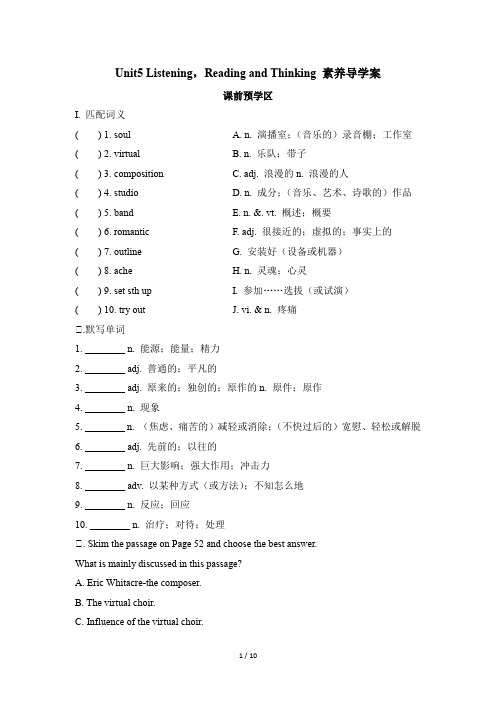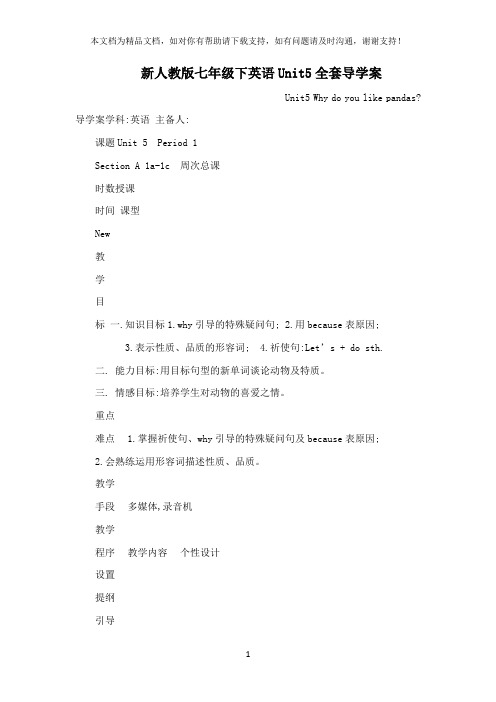Unit5 导学案
七下英语导学案Unit5

Unit 5 I’m watching TV. Section A 1a—2cNO: 0501 班级 ____ 小组 ____ 姓名 _____ 【学习目标】1.掌握短语:doing homework, watching TV, cleaning, eatingdinner, reading, talking on the phone2. 掌握句型:–What’s he doing? –He’s reading.---Is Nancy doing her homework? ---No, she isn’t. She’s writing a letter.3. 学会询问和表达人们正在做的事情。
【学习重点】:学会询问和表达人们正在做的事情。
【学习过程】:一、预习指导、自主学习学习任务一: 熟练掌握本课单词1.听磁带跟读第5单元单词2遍,自己读一遍2.你能写出下列单词划线部分的音标吗?cl ea n /______/ r ea d /______/ ap ar tment /______/s ure /______/ w ai t /______/t oy /______/ w e st /______/sh o p /______/p oo l /______/c a mera /______/ b ir d /______/3. 完成1a,图片中的人正在做什么(P25)?a: watching TV b:_________________ c:__________________d:_____________ e: _____________ f: __________________4. 听录音1b, 用英语写出你听到的人正在做的事情(P25):Jenny _____________ John_____________Dave and Mary_____________再听一遍,你听到的问句有_____________________?____________________________?___________________________?Report:Jenny is watching TV. The TV show is ______________.John is _______________.Dave and Mary ____ _________________.学习任务二: 掌握句型5. 根据单复数,将下列单词填入短文。
unit5导学案Microsoft Word 文档

Unit 5 It must belong to Carla第二课时: sectionA2a—2c 编写人:邹华丽授课教师:课时:1课时授课时间:2012年秋第周星期第节本单元主要学习情态动词: must / may / can / might / could 表推测的用法,学会用这些情态动词谈论某种可能性。
【学习目标:】一掌握本课时生词的正确发音及拼写:1,belong 属于2,belong to 属于3, author 作家,作者4,picnic 郊游,野餐5,hair band 发带6, possibly 可能地(30%的可能性)二掌握短语belong to 的用法。
三掌握情态动词:must / may / can / might / could 表推测的用法。
四、情感目标:引导学生动脑观察,比较事物的特点与区别,逐步培养自己的推理、判断能力。
【学习重难点】1 belong to 的用法。
2 情态动词:must / may / can / might / could 表推测的【学习过程】(一)自主学习1、课前复习下列句型:用whose 询问物体所有者,用be 和所有格及名词性物主代词和形容词性物主代词进行回答:A,这是谁的书?_____ ______ is this? 或:_____ is this book?B,这是王平的书。
This is __________ book. = This book is _____________C,这是他的/我的书。
This is ____/ _____ book.= This book is ____/ _____.(二) 合作探究:1、belong to 的用法:重点词组,意为:“某物属于某人或某人属于某个组织或团体”后接宾格。
如:这是我的书。
This book belongs to me.=This book is _____= This is __ book .我是这个游泳俱乐部的成员。
Unit 5 First aid 导学案

Unit 5 First aid 导学案编制:高二英语组Learning aims(明确目标):1. Knowledge aims: To know more aboutfirst aid2. Ability aims: To improve the reading and thinking abilities.3. Emotional aims:To direct the students to change their attitudes toward their life and study.Learning methods(学习方法):Skimming, scanning, group work and pair workLearning steps:(学习过程)Part 一What is First aid ?First aid is a ____________________ given to someone who suddenly _______ or __________ before a doctor can be found. Often the _____ or ______ is not_______, but there are other times when giving ________________will save ______ .Part 二What situation can you think of that needs first aid? ——————————————————————————————Part 三How much do you know about First Aid ?1. The best way to treat a sprained ankle is to:A.Put some ice on your ankle.B.Put a heating pad(垫子)around your ankle.C.Keep on walking and jumping.2. If you get a nosebleed, gently let your head back to stop the bleeding.A. TrueB. False 3. To treat a burn, you should:A. Rub(擦)some butter on it.B. Hold the burnt part under cold running water.C. Put salt on the burnt part.4. To treat a choke, you should make him /her spit by patting him/her on the back.A. TrueB. False5. To treat a bleeding, you should put a bandage on the wound and apply pressure to reduce the bleeding. A. True B. False6. To treat a broken arm, you:A. move the broken bone in no time.B. keep the arm still using a sling to support the broken armPart 四Fast Reading>In which order are these topics covered in the text? Number them from 1 to 5._____ the three types of burns_____ what to do if someone gets burned_____ the purpose of skin_____ the symptoms of burns_____ how we get burnsPart 五ScanningPart 1 What can skin do for our body ? ——————————————————————————————Part 2 Causes of burnsPart 3 Types of burnsPart 4Types of burnsTypes & characteristics of burnsPart 5 True or False1. If you are burned, you must remove clothing even if it is stuck to the burn.()2. We shouldn’t rub the burns()3. Sometimes, we can put oil or ointments on burns to stop the infection. ()4. We should make sure the bandage won’t stick to the skin when it is used. ()5. If burns are on the face, we should make the victim lie down. ()Part 6 Summary of first aid treatmentHow will her mother deal with the burn?1. ________ clothing and jewellery near the burns.2. ______ the burns with cool water.3. ______ cool, clean wet cloths on the burns.4. ______ the burned area gently.5. ______ the burned area with a dry clean bandage.6. ______ the burned area ______ than the heart, if possible.7. ______ the victim ____the doctor or hospital, if possible.Part 7 Homework• 1. Learn the new words by heart.• 2. Read the passage “First aid for burns” carefully and pay attention to the useful words and expressions.• 3. Finish Exx.1-2 on page 3。
Unit 5 Music Listening,Reading and Thinking 素养导学案

Unit5 Listening,Reading and Thinking 素养导学案课前预学区I. 匹配词义( ) 1. soul A. n. 演播室;(音乐的)录音棚;工作室( ) 2. virtual B. n. 乐队;带子( ) 3. composition C. adj. 浪漫的n. 浪漫的人( ) 4. studio D. n. 成分;(音乐、艺术、诗歌的)作品( ) 5. band E. n. &. vt. 概述;概要( ) 6. romantic F. adj. 很接近的;虚拟的;事实上的( ) 7. outline G. 安装好(设备或机器)( ) 8. ache H. n. 灵魂;心灵( ) 9. set sth up I. 参加……选拔(或试演)( ) 10. try out J. vi. & n. 疼痛Ⅱ.默写单词1. ________n. 能源;能量;精力2. ________adj. 普通的;平凡的3. ________adj. 原来的;独创的;原作的n. 原件;原作4. ________n. 现象5. ________n. (焦虑、痛苦的)减轻或消除;(不快过后的)宽慰、轻松或解脱6. ________adj. 先前的;以往的7. ________n. 巨大影响;强大作用;冲击力8. ________adv. 以某种方式(或方法);不知怎么地9. ________n. 反应;回应10. ________n. 治疗;对待;处理Ⅱ. Skim the passage on Page 52 and choose the best answer.What is mainly discussed in this passage?A. Eric Whitacre-the composer.B. The virtual choir.C. Influence of the virtual choir.D. Compositions of Eric Whitacre.Ⅱ. 话题探究(选做题)Recite the following sayings about music and voice your own opinion about music according to them.1. Music has charms to soothe a savage breast, to soften rocks or bend a knotted oak.(William Congreve)2. Sunshine can burn you; food can poison you; words can condemn you; pictures can insult you;music cannot punish-only bless.(Artur Schnabel)3. Music is the universal language of mankind.(Henry Wadsworth Longfellow)课中导学区研读教材Task 1 Pre-readingLook at the following pictures and answer the questions.1. Match each band with its name.(1)________(2)________(3)________(4)________ (5)________A. The BeatlesB. The Backstreet BoysC. Twelve Girls BandD. The EaglesE. Beyond2. Can you list some songs of each band?__________________________________________________________________________________________________________________________________________ 3. Which band do you like best? Why?_____________________________________________________________________ _____________________________________________________________________ Task 2While-reading1. Read the passage on Page 52 and match the main idea with each paragraph. ( ) (1)Para. 1 A. The creation and the development of the virtual choir.( ) (2)Para. 2 B. What the virtual choir means and its significance.( ) (3)Para. 3 C. Eric Whitacre’s life before the creation of the virtual choir. ( ) (4)Para. 4 D. The virtual choir is making the world a better place.2. Read the passage on Page 52 carefully and choose the correct answers.(1)What is the correct order of making a virtual choir?a. Upload these videos onto the Internet.b. Put all videos together into one.c. Record yourself while you perform alone on video.d. See a virtual choir online.A. cabdB. bcadC. dabeD. abed(2)What is the author’s attitude towards the virtual choir?A. Negative(消极的).B. Positive.C. Objective.D. Doubtful.(3)When did Eric Whitacre fall in love with Mozart’s classical music?A. He began studying music.B. He received a video of a girl.C. He graduated from university.D. He sang for the university choir.(4)When was the Virtual Youth Choir for UNICEF first seen on stage?A. ln1988.B. In1997.C. 1n2009.D. In 2014.Task 3 Post-reading1. Fill in the blanks according to the passage on Page 52.2. According to the passage on Page 52, how do you understand “the virtual choir”? _____________________________________________________________________ _____________________________________________________________________ _____________________________________________________________________3.What impact do virtual choirs have on our lives?_____________________________________________________________________ __________________________________________________________________________________________________________________________________________课堂思学区夯实基础I. 完成句子1. This is the first time in my life that Isuch a grand celebration. 这是我有生以来第一次参加如此盛大的庆典。
人教版英语八年级上册Unit5导学案及答案

Unit5:Do you want to watch a game show ?Section A一、单词、短语、句型默写1、情景喜剧2、新闻节目、新闻3、肥皂剧4、介意、头脑、心智5、忍受、站立6、教育的、有教育意义的7、打算、计划8、希望9、查明、弄清10、讨论、商量11、发生、出现12、预料、期待13、笑话、玩笑14、喜剧、喜剧片15、看游戏节目16、谈话节目17、运动节目18、才艺节目19、你认为谈话节目怎么样?20、看新闻21、一点点枯燥22、向/从......学习23、更有教育意义24、问题的答案25、看情景喜剧是放松的很好的方式。
26、我不能忍受肥皂剧。
27、我不介意它们。
28、我希望找出世界各地发生了什么事情。
29、开展关于......的讨论30、我最喜欢的电视剧节目31、我希望有一天成为电视台记者。
二、单元语法讲练动词不定式是动词的一种非谓语形式,,其结构是“to+动词原形”,动词不定式的否定形式是在to前面加上not(即not+to+动词原形)。
动词不定式的用法如下:1、作主语:动词不定式作主语通常用it来作形式主语,而把动词不定式结构放在句子后面。
常见句型:It’s +形容词+for sb +to do sth .(翻译)喂养动物是我的工作。
对于我们来说早上读英语是很重要的。
2、作宾语或宾语补足语:即两个动词在一个句子中前后通常用to连接,to后跟动词原形。
注意:动词不定式的否定形式是在to前面加上not。
(翻译)他想去购物。
他想要我保持房间整洁。
我决定了什么时候去旅行。
他要求我在上学的日子不要看电视。
注意:(1)一听(hear)二看(see、watch)三使让(make、let)后跟动词原形不加to。
I hope I can make my dream (come) true one day . I saw them(bring)out the best in them on TV yesterday .(2)有些动词如like、love、enjoy、spend、finish、keep、mind、practice等后面的动词只能接动词ing形式。
九年级英语导学案 Unit 5 What are the shirts made of

Unit 5 What are the shirts made of?(第 1 课时)【学习目标】1.知识与技能目标:1). 学会四会单词 restroom ;fresh ;uncrowded ;safe ;dress up; direct; order; wonder.2).掌握宾语从句的用法.2.过程与方法目标:1) .学会有礼貌的向他人询问信息2).学会准确地描述地理位置,给他人指路或提供帮助。
3.情感、态度与价值观目标:学会有礼貌地寻求信息,培养学生乐于助人的精神。
【自主梳理】1.要求学生翻开课本P33,迅速阅读la部分的内容。
并按要求完成课本上相应的任务。
2.检查答案,先要求全班一起给出答案并检查讨论。
【重点领悟】教学 What is/ are sth made of ? Where is/arc sth made in?【探究提升】二、被动语态(一)语态:英语的语态是通过动词形式的变化表现出来的。
英语中有两种语态:主动语态和被动语态。
主动语态表示主语是动作的执行者。
例如:Many people speak Chinese.谓语:speak 的动作是由主语 many people 来执行的。
被动语态表示主语是动作的承受者,即行为动作的对象。
例如:Chinese is spoken by many people. 主语 English 是动词 speak 的承受者。
(二)被动语态的构成被动语态由“助动词bc+及物动词的过去分词”构成。
人称、数和时态的变化是通过be的变化表现出来的。
现以speak为例说明被动语态在各种时态中的构成。
一般现在时:am / is / are4-spoken一般过去时:was / were+spoken一般将来时:will / shall be+spoken现在进行时:am / is / are being4-spoken过去进行时:weis/were being+spoken现在完成时:have / has been + spoken过去完成时:had been + spoken(三)被动语态的用法(1)不知道或没有必要说明动作的执行者是谁。
八年级英语上册Unit 5 导学案完整版

Unit5 Do you want to watch a game show?Section A 1a—1c 第一课时【学习目标】1.会读背单词:news, educational, plan, hope, discussion, stand, talent show, learn …from…., plan/hope to do sth. 2.谈论各类电影和电视节目的名称。
3.句型:---- What do you think of game shows?---- I like them. / I love them. / I don’t like them. / I can’t stand them. /I don’t mind them.【学习重点难点】学会询问他人对某事物的观点并会正确表达自己的看法。
---- What do you think of game shows?--- I like them. / I love them. / I don’t like them. / I can’t stand them. /I don’t mind them.【学法指导】主动读记单词、自觉捕捉听力中的关键词、听后跟读、读用重点句型【教学过程】一、导入Do you like to watch TV? What kind of TV program do you knowGuide students to say some TV programs.二、自学(一)预习指导1.写出下列单词并展示.计划____希望___ 预料_____忍受_____ 情景喜剧_____ 新闻_____肥皂剧__________2..在小组内核对答案.3..完成1a 将单词与图画匹配.2.将1a中单词与图画匹配。
(二)预习检测1.同桌互相提问短语,把1a词组译成汉语。
1. talk show 5. game show ______2. soap opera 6. talent show ______3. sports show ______ 7. news ______4. sitcom ______2..两人一组合作练习1c。
三年级上册英语导学案-Unit5ALet'stalk-人教PEP

教学目标1. 知识目标(1) 能够听懂、会说、会读本课的核心单词:panda, tiger, bear, look, see, animal.(2) 能够听懂、会说、会读本课的句子:What's this? It'sa/anWhat's that? It's a/anLook at the They are2. 能力目标(1) 能够正确运用核心单词和句子描述动物,并能够运用到实际情景中。
(2) 能够借助图片、情景等线索,运用所学知识进行简单的交流。
3. 情感目标通过学习,培养学生热爱大自然、关爱动物的情感。
教学内容本课主要学习三年级上册英语PEP教材Unit 5 A Let's talk部分,通过学习,学生能够掌握描述动物的单词和句型,并能够运用到实际情景中。
教学重点与难点1. 重点:能够听懂、会说、会读本课的核心单词和句子。
2. 难点:能够正确运用核心单词和句子描述动物,并能够运用到实际情景中。
教具与学具准备1. 教具:PPT、动物图片、单词卡片、录音机、磁带。
2. 学具:课本、练习册、铅笔、橡皮。
教学过程Step 1: Leadin1. 教师播放动物声音,让学生猜测是哪种动物。
2. 学生回答后,教师展示相应动物的图片,引导学生说出动物的名称。
Step 2: Presentation1. 教师出示单词卡片,引导学生认读核心单词:panda, tiger, bear, look, see, animal。
2. 教师通过情景展示,引导学生学习本课的句子:What's this? It's a/anWhat's that? It's a/anLook at the They areStep 3: Practice1. 教师组织学生进行小组活动,让学生运用所学单词和句型进行交流。
2. 学生两人一组,进行角色扮演,模拟情景对话。
Step 4: Consolidation1. 教师出示一个动物园的情景图,让学生根据图中的情景,运用所学知识进行描述。
Unit5RevealingNature导学案高二英语选择性

选择性必修一Unit5 Revealing Nature 导学案一.单词1. seed /siːd/ n.种子,籽2. distant /ˈdɪstənt/ adj.遥远的3. answer the call响应号召4. disgrace /dɪsˈɡreɪs/ n.丢脸,耻辱5. be a disgrace是耻辱,是丢脸的事6. geologist /dʒiˈɑːlədʒɪst/n.地质学家7. sample /ˈsɑːmpl/ n.样本8. evolve /iˈvɒlv/ v.进化9. finch /fɪntʃ/ n.雀科鸣禽10. beak /biːk/ n.鸟嘴,喙11. suspect /səˈspekt/ v.猜想,怀疑,觉得12. ancestor /ˈænsestə(r)/ n.(动物的)原种,祖先13. evolution /ˌiːvəˈluːʃn/ n.进化(论)14. generate /ˈdʒenəreɪt/ v.产生,创造15. characteristic /ˌkærəktəˈrɪstɪk/ n.特征,特性16. decline /dɪˈklaɪn/ v.减少17. tortoise /ˈtɔːtəs/ n.陆龟18. blame /bleɪm/ v.责怪,指责;把……归咎于19. goat /ɡəʊt/ n.山羊20. be native to源于……的,原产于……21. primitive /ˈprɪmətɪv/ adj.原始的,低等的22. worldwide /ˌwɜːldˈwaɪd/ adv.遍及全世界23. giant /ˈdʒaɪənt/ adj.巨大的,特大的24. giant tortoise巨型陆龟25. mangrove /ˈmæŋɡrəʊv/ n.红树(一种热带树木,生于水中或水边,并从树枝上长出新根须)26. iguana /ɪˈɡwɑːnə/n.鬣蜥(一种大型热带美洲蜥蜴)27. blike /koʊm laɪk/adj.梳状的28. spine /spaɪn/n.(动物的)刺,刺毛29. myth /mɪθ/ n.(古代的)神话30. legend /ˈledʒənd/ n.传说,传奇(故事)31. detect /dɪˈtekt/ v.发现,察觉(尤指不易觉察到的事物)32. wasp /wɒsp/ n.黄蜂33. pesticide /ˈpestɪsaɪd/ n.杀虫剂,农药34. root /ruːt/ n.根35. chilli /ˈtʃɪli/n.辣椒36. link /lɪŋk/ v.把……联系起来;连接37. fungus /ˈfʌŋɡəs/ n.真菌(复数fungi)38. fungal /ˈfʌŋɡl/adj.真菌的39. cybercrime/ˈsaɪbəkraɪm/ n.网络犯罪40. centimetre /ˈsentɪmiːtər/n.厘米二.短语1.date back to 追溯到2.be a disgrace 是耻辱,是丢脸的事3.answer the call 响应号召4.of all time 有史以来5.in question 讨论(议论)中的6.be crowded with 挤满7.e to exist 产生8.adapt to 适应9.be native to 源于……的,原产于……10.be home to 是……的栖息地/家乡11.so far 到目前为止12.carry out 完成(任务);执行;实施13.drive...away 驱赶走……三.课文Unit 5 Revealing naturePassage1A Journey of Discovery发现之旅The captain of the ship, the Beagle, wanted someone who would “profit by the opportunity of visiting distant countries yet little known”. The person who answered the call was not the captain’s first choice. It was a young man who had left medical school without pleting his degree. What’s more, he had recently received a letter from his father predicting that he would be “a disgrace to yourself and all your family”. Despite all this, his adventures on this ship would lead to one of the most important scientific discoveries of all time.The young man in question, Charles Darwin, was a geologist and naturalist, fascinated by rocks, plants and animals. He left England on the ship, the Beagle, in 1831. The journey gave him the chance to study various living things in their natural environments. After Darwin had spent some time in South America, his room on the ship was crowded with samples of the plants and animals he had collected. As he studied these, he asked himself the question: how did different species e to exist?At that time, people believed that all species had appeared on Earth at the same time, and had not changed since. But Darwin began to think differently. He noticed that some species of animals were very similar to each other. Maybe animals evolved as they adapted to their changingenvironments? It was just an idea, but enough to inspire Darwin to look for more evidence.When the Beagle reached the Galápagos Islands in 1835, Darwin saw a variety of new species, but it was the birds that interested him the most. Darwin noticed that there was a difference between the finches on each of the islands. It seemed their beaks had evolved according to what food was available on that particular island.Darwin suspected that the finches had evolved from a mon ancestor, which had arrived on the islands a long time before. Over time, it had slowly evolved into many new species. And that was the answer to how new species of plants and animals came to exist: they evolved from earlier ancestors.It was a pletely new idea—a theory of evolution. Darwin explained this theory in his book, On the Origin of Species. It was not published until 1859 and immediately caused a storm. Many people refused to believe that living things, including humans, had evolved from lower forms of life. They were shocked. But Darwin’s scientific studies were so convincing that more and more people started to believe his theory.Today, On the Origin of Species is regarded as one of the most important works ever written. It has changed ideas about life on Earth forever. And it all began with the journey on the Beagle.贝格尔号的船长想要招募这样一名船员,这名船员将能“借此机会访问遥远而鲜为人知的国家并从中受益”。
新人教版七年级下英语Unit5全套导学案(可编辑)

新人教版七年级下英语Unit5全套导学案 Unit5 Why do you like pandas? 导学案学科:英语主备人:课题Unit 5 Period 1Section A 1a-1c 周次总课时数授课时间课型New教学目标一.知识目标1.why引导的特殊疑问句; 2.用because表原因;3.表示性质、品质的形容词;4.祈使句:Let’s + do sth.二. 能力目标:用目标句型的新单词谈论动物及特质。
三. 情感目标:培养学生对动物的喜爱之情。
重点难点 1.掌握祈使句、why引导的特殊疑问句及because表原因;2.会熟练运用形容词描述性质、品质。
教学手段多媒体,录音机教学程序教学内容个性设计设置提纲引导I、预习交流1. 根据音标拼读单词并牢记;2. 自学课文,勾画出重点和疑惑。
II、翻译官1. welcome to the zoo ___________2. my favorite animals ______________3. want to see them______________4大象_________________________5. 树袋熊,考拉 ______________ 6. 长颈鹿________________________ 自主探究,请带着下面这些问题阅读教材。
Let’s 后接动词的什么形式?why 引导的特殊疑问句可用什么进行回答?激趣生疑明确目标T: Did you go to the zoo?S: Yes ,I do / No , I don’tT: What animals do you like?S: I like ……Now ,let’s see the animals.Do you know their names? Please answer in English.明确目标:Today ,let’s talk about what animals you like ,and learn to talk about why you like them展示交流释疑一.回顾已知,导入新课1.不能在走廊上跑。
八年级英语下册导学案 Unit 5

Unit 5. If you go to the party , you’ll have a great time 学案主备人:陈京豹二备人:第一课时(1a—1c 及语法)一.学习目标:1。
本课时重要词组。
2。
if 引导的条件状语从句的使用。
二.重难点:if 引导的条件状语从句的使用。
三.学法指导:以学生自学为主,教师点拨,习题巩固。
四.本课时重要词组:go to the party with sb 与某人一起参加聚会wear jeans to the party 穿牛仔裤参加聚会stay at home 呆在家里let sb in 让某人进入be late 迟到be sorry 后悔have a great / good time 玩得开心/愉快五. 语法:if 引导的条件状语从句1.含义与结构If 意为“如果”,可用来引导条件状语从句,带有条件状语的句子属于复合句,从句表示主句动作发生的前提或条件.结构: if + 陈述句,主语+ 谓语(= 主语+谓语+ if + 陈述句).如:If you ask him, he will tell you the answer .如果你问他,他会告诉你答案.You can leave now if you like .如果你愿意,现在就可以走了.2. 用法. If 引导条件状语从句时,主句用一般将来时,从句则用一般现在时.如:If it rains tomorrow , they won’t climb the hill . 如果明天下雨,他们就不去爬山.If 引导条件状语从句时,主句是祈使句时,从句也用一般现在时.如:If he comes ,please let me know . 如果他来,请让我知道.If 引导条件状语从句时,主句是含有情态动词的句子,从句也要用一般现在时.如:You should eat less meat if you is fat . 如果你是胖的,你应该少吃肉.3.特别注意: 条件状语从句通常由连词if 引导,意为“如果,假如”这时主句不能用be going to 表示将来,而应该用shall , will 等.如:If you leave now ,you are never going to regret it ( 错误)If you leave now ,you will never regret it .(正确)注意引导宾语从句的if 与引导条件状语从句的if 的区别.引导宾语从句的if 意为“是否”,相当于whether , 宾语从句的时态要根据语境确定.如: I don’t know if it will rain tomorrow 我不知道明天是否会下雨.专题训练: 1 . If he _____ harder , he will catch up with us soon .A. studyB. studies C . will study D .studied2.There is going to ____ a sports meeting next week ,if it ____ ,we’ll have to cancel it .A. be ,will rain B .have , will rain C .be ,rains D .have , rains .3. I’m waiting for my friend ._________ , I’ll go shopping alone .A. if she comesB. if she will comeC. if she doesn’t come D .if she didn’t come4.I don’t know if she ______ to the party , if she ______, I’ll tel l you .A. comes , comes B .will come , will come C .comes , will come D. will come, comes 5.----- Mary , what about going boating ,if it ______ tomorrow ? ------Good ideaA. won’t rainB. not rain C, doesn’t rain D.will rain6. if the snow _____we’ll have to stay at home . A. stops B .doesn’t stop C. will stop用单词的适当形式填空.1.If she _________ (finish ) work early ,she ___________(go) home.2.If the weather________(be)fine,we___________(go)for a walk .3. If I__________(have) time tonight ,I ________ (finish) the book I’m reading.4. If it________(rain) next weekend ,we________ (not be able to ) plant the vegetable .5.If it_______(rain),we________(stay)at home6.If she______(arrive) ,she _________(phone) me .7. If he_____(call),tell him I’ll ring back .8. He _____(not speak ) to you unless you_____(speak) to him first .9. I don’t kn ow if it __________(rain) tomorrow .If it __________(rain) , we ______________(not go )to school五.本课时必默写课文1a .第二课时(2a—4)主备人:陈京豹二备人:一.学习目标:1. 重要词组. 2. half 与half of 的区别,why not 的使用,不定式作定语. 二.重难点:重点单词的使用.三.学法指导:学生自学,教师点拨,多读多记.多习题训练四.本课时重要词组:study for the test 为考试而学习too early 太早make some food 做一些食物play party games 玩聚会游戏have the party 举办聚会watch a video at the party 在聚会上观看录像a good time to have the party 举办聚会的好时间bring food to the party 带食物去参加聚会the rules for school paries 学校聚会的规则take away 带走拿走friends from other schools 来自其他学校的朋友ask sb to do sth 要求其人做某事during the party 聚会期间ID card 身份证五,重点句子解析:1.When is a good time to have the party ? 什么时候举行聚会比较好。
Unit 5 Revealing nature Developing ideas(导学案)-高中英语

. 终究,毕竟7. 赶跑释放微量的化学物质8.植物万维网. 也会发生网络犯罪9.从……偷某物【During class ]I : Before readingActivity 1: Watch a video about one behavior of plants.11.While readingActivity 1: Skim the passage and answer the questionsFind out the 3 ways in which plants communicate.Activity 2: Get the detailed information of para3-para5Look at the two pictures and observe what happened, (para 3)What do the chemicals work and whafs the plants' reaction.a.Listen to the plant's sound and which part of plant can make the noise.b.Fill in the blanks.Full nameWays to linkFunctionsOur world is far than the world we can see and hear. Oursenses are weak.So weshould V: Homeworka.Write a summary about the passage of the secret language of plants (within 60 words).b.Write a story about you and plants or animals.【After class ]When a leafy plant is under attack, it doesn't sit quietly. Back in 1983, two scientists, Jack Schultz and Ian Baldwin, reported that young maple trees getting bitten by insects send out a particular smell that neighboring plants can get. These chemicals come from the injured parts of the plant and seem to be an alarm. What the plants pump through the air is a mixture of chemicals known as volatile organic compounds, VOCs for short.Scientists have found that all kinds of plants give out VOCs when being attacked. It's a plant's way of crying out. But is anyone listening? Apparently. Because we can watch the neighbors react.Some plants pump out smelly chemicals to keep insects away. But others do double duty. They pump out perfumes designed to attract different insects who are natural enemies to the attackers. Once they arrive, the tables are turned. The attacker who was lunching now becomes lunch.In study after study, it appears that these chemical conversations help the neighbors. The damage is usually more serious on the first plant, but the neighbors, relatively speaking, stay safer because they heard the alarm and knew what to do.。
- 1、下载文档前请自行甄别文档内容的完整性,平台不提供额外的编辑、内容补充、找答案等附加服务。
- 2、"仅部分预览"的文档,不可在线预览部分如存在完整性等问题,可反馈申请退款(可完整预览的文档不适用该条件!)。
- 3、如文档侵犯您的权益,请联系客服反馈,我们会尽快为您处理(人工客服工作时间:9:00-18:30)。
2、watch它的三单形式是_____________,当主语是第三人称单数时,动词形式的变化规
(1)一般动词在词尾加____,在清辅音后读/s/,在浊辅音后或元音后读/z/,在t后读/ts/,在d后读/dz/。
(2)以字母s,x,ch,sh结尾的动词加____读/IZ/;
1、I have two tennis rackets.?.
2、They have a computer .?.
二、自主学习:
1、阅读P29的3a,标出不认识的单词,到P103中找到熟读并背诵。
2、熟读3a .然后完成3b.
三、合作探究:
1、.has:是have的第三人称单数形式,当主语是第三人称单数的时候,动词用has,如,
(3).以辅音字母+y结尾的,变y为i再加es。以元音字母+y结尾直接加s
(4)以辅音字母+o结尾加es;以元音字母+o结尾直接加s
do(三单)______________ play_______________ study(三单)________________
3、them:它是they的宾格形式,动词后面若接人称代词必须是宾格形式,
Unit5 Do you have a soccer ball ?导学案2 (Section A 3a—4)
学
习
目
标
1、本课词汇13个P27
2、掌握动词have的否定句式的构成。
3、掌握Let’s开头的句式。
重
点
Let’s play soccer.
I don’t have a soccer ball .
2、动词have的第三人称单数has的用法。
3、掌握规则动词三单形式的变化规则:如,watch(三单)---watches, play(三单)--plays
重
点
1、动词have的第三人称单数has的用法
2、规则动词三单形式的变化规则
难
点
谈论体育用品收藏
学
习
导
航
一、复习回顾
将下列句子变成一般疑问句,再变成否定句。
My cousin doesn’thavea computer(正确的).
My cousin doesn’thasa computer(错误的).因为doesn’t+动词原形
改错: His brother don’t have a computer game. ________________________________.
如,He only watchesthemon TV. we(宾格)___________ you(宾格)_____________
我的疑惑
1、预习P27内容,标出不认识的单词到P102找出,然后熟读并背诵。
2、完成3a,用方框中的单词填空。看一看谁填的对?
三、合作探究:
1、Let’s play volleyball
1let’s=let us, let的意思是_______,let+人称代词的宾格,us是_________的宾格
2let’s +动词原形,表示建议。如,Let’s ____________(play) soccer
我的疑惑
Unit5 Do you have a soccer ball ?导学案3 (Section B1a—2c)
学
习
目
标
掌握单词及短语:六个形容词(interesting,boring,fun,difficult,relaxing,great),watch,
重
点
形容词的用法
难
点
运用表示品质的形容词评价活动
3形容词,在句中作定语,后面接名词,修饰名词,如,This isan______________book.
4interseting的反义词是________________.
3、Pairwork结对活动:仿照示例谈论活动
( play volleyball ,watch TV , play basketball ------)
你还记得一般疑问句的变换方法吗?
二、自主学习:
1、预习P25-26内容,标出不认识的单词,然后到P102找出,熟读并背诵。
2、完成1a内容,将单词与图中物品匹配。看谁找得对?
三、合作探究:
1.do的用法:
I have a basketball .变成一般疑问句
Do you have a basketball?Yes, I do.
I have a volleyball.(变成否定句)
变换方法是:
四、预习感知:用所给单词的适当形式填空
1、I don’t____________(have) a soccer ball.
2、Do you ___________(have) a dictionary?
3、Let’s ___________(play) volleyball.
A: Let’s play computer games .
B: That sounds interesting .
A: Let’s play ------
我的疑惑
Unit5 Do you have a soccer ball ?导学案4 (Section B3a—4)
学
习
目
标
1、掌握单词及短语has,but,only,them,every day,watch TV,play basketball,play volleyball,play computer game.
2、完成P28中1a:将单词与图片匹配。
三、合作探究:
1.sound
作系动词,意思是听起来,后面接形容词,如,That sounds _______________(有趣的);
That sounds _______________(无聊的); That sounds ______________(令人愉快的);
That sounds___________________(困难的);That sounds_______________(轻松的)
2.interesting
1形容词,在句中作表语,位于系动词后面,如,This book is ______________.
2That sounds _________________.
四、预习感知:
1、你学会了吗?试试看:将下列句子变成一般疑问句并作出肯定、否定回答。
1)、I have a ball .? Yes,. No,.
2)、I have a book .? Yes,. No,.
2、小组合作完成2c。询问对方是否有某物?比一比哪组最流利?
我的疑惑
Unit5 Do you have a soccer ball ?导学案1 (Section A 1a—2c)
②作名词,意思是_________,如,I have 7classesevery day.(我每天上7节课)
5、I have a ruler .变成否定句:I don’t have a ruler .
They have books.变成否定句:They don’t have books .你学会了吗?试一试:
学
习
导
航
一复习回顾:翻译下列短语
watch TV________________ ,play basketball __________
play volleyball ________________ play computer game.__________
二、自主学习:
1、预习P102中P28的单词,熟读并背诵。
That sounds good .
难
点
提建议的表达方法
学
习
导
航
一、复习回顾
将下列句子变成一般疑问句,并作出肯定、否定回答。
1、They have a computer .?(否定回答)
2、She has a TV .?(肯定回答)
3、He has a tennis racket .?(否定回答)
二、自主学习
学
习
目
标
1、本课词汇13个P25-26
2、掌握动词have的一般疑问句式的构成及其回答。
重
点
词汇及have一般现在时的用法
难
点
运用have谈论物主关系
学
习
导
航
一、复习回顾
将下列句子变成一般疑问句并进行肯定、否定回答。
1、This is my picture .?,(肯定回答)
2、Those are my photos .?,(否定回答)
2、sound v.听起来。感官动词充当连系动词后接形容词作表语。
That sounds great .那听起来好极了(用来回答建议的)
3、many许多、大量
many+复数名词,如,We have many sports ___________(club).
4、cห้องสมุดไป่ตู้ass
①作名词,意思是_________,如,I am inClass 6(我在6班).
Dothey have a soccer ball? No, theydon’t。
Doesshe have a computer? No, she doesn’t
Doeshe have a ping-pong ball? Yes,he does./No,hedoesn’t.
句中的do和does都是构成疑问句和否定句的助动词
do not的缩写形式_______________ does not的缩写形式_______________
